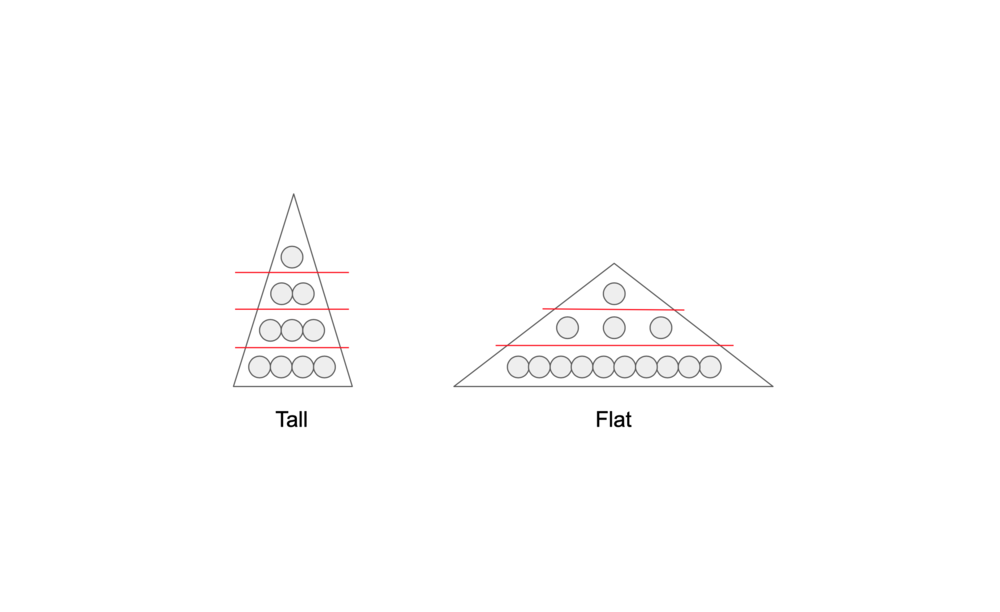
Most businesses usually start as a one-man show or with very few people. Communication is easy, transparency over what everyone’s doing is high, and you as the founder manage all of your team members directly. This works fine, until the day when it doesn’t anymore. There comes the point where you will need additional management capacity. In this blog post, we want to have a closer look at how to determine that point. To do this, let’s first have a look at some theory – not for the theory’s sake, but because it gives us a great framework to decide whether we need to bring on or develop a manager or not.
Fundamental methods of coordination
In every company, labour is divided in a way, and tasks have to be coordinated. Let’s have a look over how we coordinate tasks as this will influence our need for a management layer.
INFORMAL COMMUNICATION
Informal communication plays a significant role in the beginning. You just quickly chat about things with your three team members, and everyone knows what’s the deal. A quick text message here, a short call there, and colleagues helping each other out. In the very early days, this informal way of coordination is very common. And it plays its part in every company; the question is how big that part is. In short, if you’re able to establish an efficient, task-focused level of informal communication, this will reduce your need for additional management capacity. Temporary or self-managed teams can also be considered a form of informal communication.
STANDARDIZATION
Standardizing is another way of coordinating work without having to establish hierarchy. Obviously, standardization requires a rather stable environment regarding customers, competitors and suppliers, but it for sure should have its place in every company. The more standardized task execution is, the less management attention it needs.
FORMAL HIERARCHY
Last but not least, a formal hierarchy is probably the coordination method you’d think of first. It’s about assigning power to individuals who then coordinate work execution using that power.
Span of control
Another management concept worth knowing when bringing a manager into the company is the span of control. It describes how many people are managed directly by a given supervisor. Let’s say you’re the only person in your company that your team reports to and you have five employees, your span of control would be five. When talking about span of control, we usually think of tall structures and flat structures.

Tall structures have a narrow span of control (little number of direct reports) and many hierarchy levels. They usually come with high overhead costs due to many managers and slow information flow.
Flat structures have a wide span of control, but only a small number of hierarchy levels. If you’re the only manager in your company, you have a super flat structure.
The manageable span of control is bigger if the tasks performed are routine, roles are not very highly interdependent and when the other coordinating mechanisms play a bigger role. Let’s take an automotive assembly line, where tasks are highly standardized. The span of control might be ten or even 50 people. On the opposite side of the scale, take an engineering team. Tasks are very unstandardized, and interdependency between a designer and the engineer is very high – such a setup requires a much smaller span of control, say 5 people.
Do I need to create a manager position?
Thanks for bearing with me here. Now, when you read this article, you probably think about bringing in a manager. This means that the span of control you are trying to manage is too big, given the other coordinating mechanisms of standardization and informal communication and the nature of your business. To make this concrete, managing your ten team members all on your own might simply feel too much and doesn’t leave you time to work on strategic initiatives.
WORK ON ALL COORDINATING MECHANISMS
Bringing in a manager is a costly decision, so it is worth looking at what alternatives you have to close your coordination gap. Think about all the other options you have to achieve your level of coordination.

STANDARDIZE
One way to buy yourself time before you have to hire a manager is to standardized tasks. This might work well if you are in a mature and stable industry with a business model and processes that don’t change much.
STRENGTHEN AUTONOMY
When your surrounding is rather dynamic, try to increase informal communication. Create temporary teams, assign decision power to your employees and foster direct communication and conflict resolution between your team members.
BRING IN A MANAGER
Especially for a growing company, tasks are usually very non-routine and surroundings change quite considerably. Also, through merely growing, you will increase the span of control to an extent that can’t be compensated just by strengthening the other control mechanisms. So you will have to bring in someone that decreases your span of control again.Your goal is to find a mix of all those mechanisms that best suits your business model.
I want to create a management position, now what?
If you want to create that management position, there are several questions to answer.
DEDICATED MANAGER OR TEAM REPRESENTATIVE
Please make up your mind whether you want that management position to be dedicated to management or a team member that is your contact point into the team. The last option only works if the direct reports of that management position all do the same tasks, e.g. as in a team of copy-writers. Otherwise, the position would be too biased to resolve conflicts within different roles within the team, and you should opt for a dedicated management position.
FUNCTIONAL OR DIVISIONAL STRUCTURE
You need to decide whether you want to structure your organization by function or by division. A functional structure is usually what most businesses start with as it comes naturally – you will have a marketing team, a finance team, a purchasing team.In contrast, a divisional structure might make sense if you want to put specific emphasis on one aspect of your business, e.g. a customer group or specific markets. You could decide to create a manager position for European clients or small business clients, combining all necessary resources under that position.
Read more about organizational structures here.
INTERNAL OR EXTERNAL
Whether you bring in a manager from the outside or develop someone from the team, both approaches have their pros and cons. The biggest pro for bringing in is fresh ideas and expertise, whereas developing someone internally ensures the highest identification with and knowledge of your business. Be aware that both ways require intensive training and onboarding, be it on company specifics or management capabilities.
WHAT’S YOUR GOAL
Base your answers on these questions on your goals: If you want to free up some of your time to work more strategically, than a representative from internal in a functional structure might be the best choice. Example: You make one of your marketing team members your marketing manager and thus don’t have to manage the remaining four marketing reps directly anymore.if you, on the other hand, want to professionalize your account management team, you might want to bring in an experienced account manager from the outside.
Let me know your experience with hiring a manager.
Happy Scaling!
Best
Benjamin

